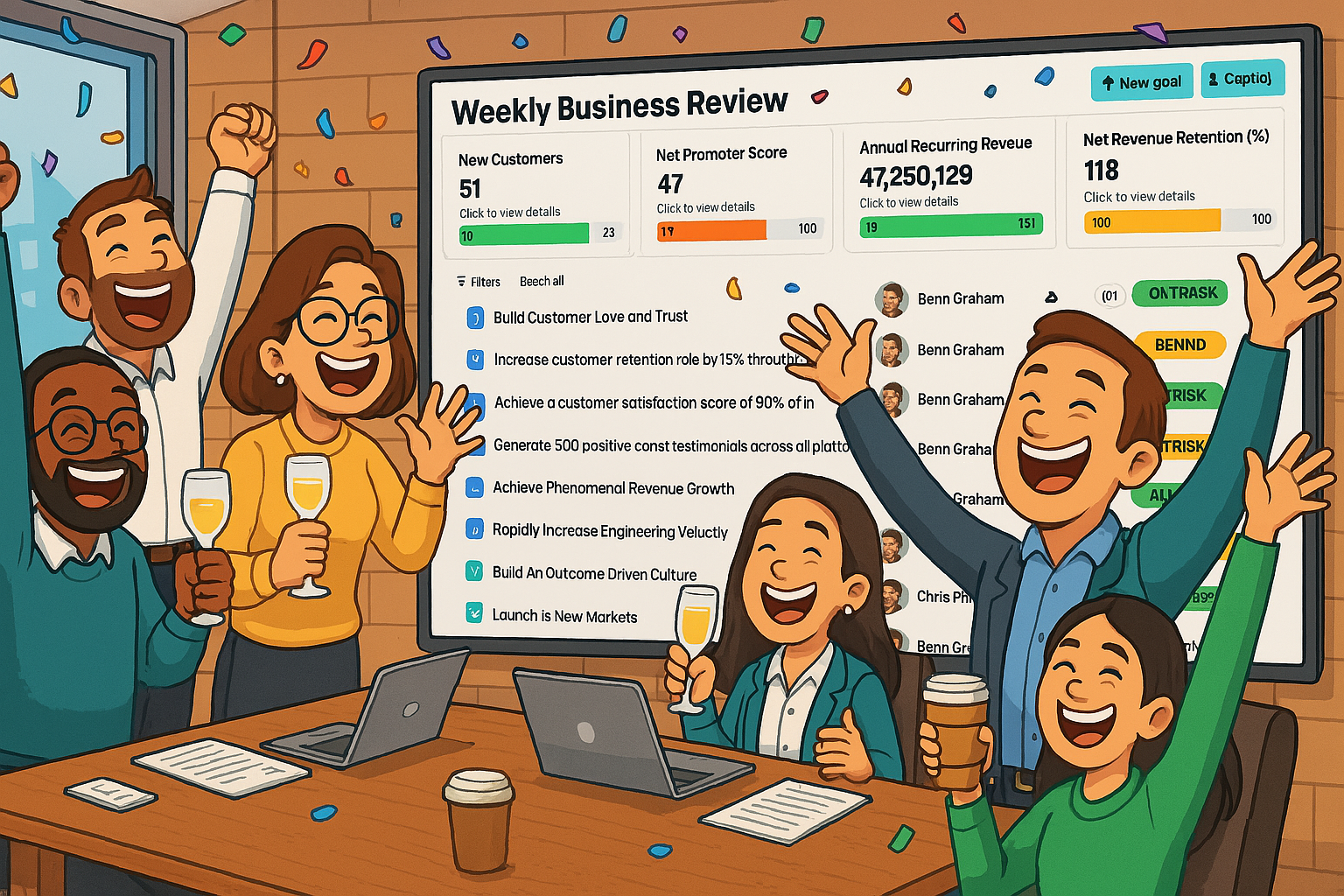TL;DR
Running weekly business reviews (WBR) with AI enables clear structure, real‑time insights, and AI-driven automation to keep your team aligned and execution on track. In this post, learn how to run your WBRs with AI—streamlining data collection, surfacing risks, and automating draft updates so your team focuses on decisions, not decks.
Why Weekly Business Reviews Matter (and Where They Often Stall)
Weekly business reviews are your heartbeat: a rapid‑fire check‑in on progress, obstacles, and next moves. Yet too often they become:
-
Manual data wrangling: pulling numbers from disparate tools into slides
-
Late edits and chasing updates: “Chris, can you send your slides by 3 PM?”
-
Status rituals: reciting what everyone already knows, instead of driving action
The result? Shrinking engagement, less accountability, and execution stalls. AI can transform your WBR from a chore into a catalyst.
1. Define a Tight, Outcome‑Oriented Agenda
A focused WBR agenda keeps the meeting sharp and the team engaged. We recommend:
-
Headline Snapshot (2 min): Top three bullets—big win, biggest risk, and key ask.
-
Progress vs. Weekly Targets (5 min): Data‑backed view of KRs/KPIs vs. plan.
-
Wins & Blockers (5 min): Celebrations and immediate roadblocks.
-
Cross‑Team Dependencies (3 min): Hand‑offs and coordination points.
-
Decisions & Next Steps (2 min): Who does what by when.
Pro Tip: Limit your WBR to 15–20 minutes. Anything longer, and you lose the quick‑pulse check.
2. Auto‑Collect and Contextualize Data with AI
Stop copying and pasting. Brev’s AI connects to your:
-
Task trackers (JIRA, Asana) to pull completed vs. planned tickets
-
Code repos (GitHub, GitLab) to surface merged PRs tied to objectives
-
Sales tools (CRM) to fetch deal movements and revenue updates
-
Product analytics for user engagement spikes or drops
AI maps each signal to the relevant goal—“This feature ship moved our Week‑on‑Week DAU +8%”—so your data is always current.
3. Let AI Draft Your Core Sections
Rather than starting slides from scratch, AI generates first‑pass content:
-
Headline Snapshot: “✅ Launched widget A on schedule; 🚨 Integration tests delayed; 📣 Need QA support.”
-
Wins & Blockers: Bullet lists of last week’s major accomplishments and top three risks.
-
Progress Commentary: Short narrative on how metrics trended vs. targets.
-
Dependency Notes: Who needs what from whom, automatically pulled from workstreams.
You then review, tweak the tone, and add context. Draft‑then‑edit slashes prep time by up to 80%.
4. Surface Risks Before They Bite
AI doesn’t wait for you to notice a trend for your business reviews —you do. Examples:
-
Drift Alerts: “On pace for 40% to target by Friday vs. 70% planned.”
-
Blocker Flags: “Three tickets untouched for 5 days—owner: @alex.”
-
Correlation Insights: “Spike in support tickets aligns with yesterday’s UI change.”
Early risk detection means you can re‑allocate resources or adjust scope before Friday’s review.
5. Capture and Automate Decision Memory
Your AI business reviews become a living log, not a one‑off meeting:
-
Decision Table: AI logs each decision with rationale, owner, and due date.
-
Smart Reminders: Follow‑up nudges to owners before next WBR.
-
Context Links: Direct links to PRs, tickets, or docs so anyone can dive deeper.
Over time, this archive accelerates onboarding and eliminates “Wait, why did we choose that?” conversations.
6. Collaborate Cross‑Functionally—Seamlessly
Even in 15 minutes, include every stakeholder:
-
Pre‑Reads in Slack: AI posts the draft summary in your WBR channel 24 hours prior.
-
One‑Click Feedback: Teammates comment or annotate within the draft.
-
Rotation of Facilitators: Keep energy high by rotating who leads the review each week.
This shared prep ensures everyone shows up informed and ready to decide.
7. Iterate for Continuous Improvement
Don’t let your format calcify:
-
Weekly Pulse: AI polls participants with a 1‑question survey (“Was this WBR valuable?”).
-
Quarterly Retros: Review agenda sections—drop what’s stale, add new ones as business shifts.
-
Template Updates: Let AI adapt slide templates based on feedback and evolving goals.
Incremental tweaks keep your WBR fresh and high‑impact.
8. Scale Your Rhythm with Automation
AI business reviews aren’t a novelty—they’re a force multiplier:
-
Auto‑Generated Decks: Branded slide packs ready by Monday morning.
-
Integrated Notifications: Calendar invites, Slack reminders, and email digests all synced.
-
Data Health Checks: AI spots stale integrations or missing inputs and prompts corrections.
As your team grows, this foundation ensures your weekly reviews stay lightweight and strategic.
Ready to Run Your First AI‑Powered WBR?
-
Set Your Weekly Goals: Identify 2–3 KPIs or deliverables for next week.
-
Connect Your Tools: Link Brev to your project management, code, and sales systems.
-
Activate AI Drafts: Approve your first AI‑generated WBR and watch the magic happen.
Try Brev free for your next Weekly Business Review—and turn your weekly check‑ins into velocity drivers, not status chores.
